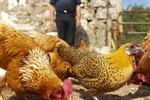Things You'll Need
Brooder box
Chicken coop
Nest boxes
Warnings
Most hatcheries require a 25-chick minimum order. If you don’t want that many pullets, consider splitting an order with someone or sell the extra chicks.
Vent-sexed pullets are only 95 to 98 percent accurate, so it is possible to get cockerels in an order of chicks. Unwanted cockerels can be sold or butchered when they reach the proper size.
Clean water is a must for all stages of a chicken’s life. Lack of water can retard the growth of chicks and will impair the egg production of laying hens. Without adequate water, hens can stop laying altogether.
Use extreme care when adding younger hens to an established flock with older hens.
Tips
Purchasing started pullets will eliminate the need for a brooder box. Because they are completely feathered, started pullets can usually go directly into a coop.
Rhode Island Red pullets will begin to lay between 16 and 25 weeks of age. Their peak productive period is about two years. Both egg quality and quantity will decrease as the hens age. To maintain egg production, add replacement pullets to the flock each year.
Put artificial lights on a timer so the additional light comes on during early morning hours and cuts off just after daylight. Allow the hens to roost in natural light at the end of the day.
The Rhode Island Red is an American breed resulting from the crossing of three breeds: Red Malay Game, Leghorn and Asiatic native stock. Named for the section of New England where they originated, Rhode Island Reds are dual-purpose birds bred for the production of meat and eggs. Under optimum conditions, a hen can produce nearly 240 brown eggs every year. The cheapest way to get started with these hens is to purchase day-old sexed pullets from a hatchery, feed store or local breeder. Purchasing chicks between the ages of 6 and 22 weeks offers a quicker, but more expensive option.

Obtain laying flock by purchasing day-old chicks from a hatchery.

Feed chicks starter crumbles with a coccidiostat for the first two weeks to help prevent coccidiosis, an intestinal disease that can be deadly to chicks. Provide access to food and clean water at all times. Feeders and waterers should be placed so the lip is the same height as the chicks' backs.

Maintain the brooder at 95 degrees for the first week and decrease the temperature by 5 degrees each week until the chicks are fully feathered.

Move chicks to the laying coop when completely feathered. Allow at least 6 inches of linear roost space per pullet. Roosts should be 2 feet off the floor.

Switch chicks to grower feed between the age of 6 and 18 weeks.

Switch pullets to layer feed containing 16 to 18 percent protein at 18 weeks. Add a separate free-choice feeder with oyster shell to help maintain the hardness of the eggshells. Do not mix the oyster shell in with the layer feed.

Provide 14 to 16 hours of light year round. One 40-watt bulb is adequate for each 100 feet of coop space.

Install one nest box for each five hens. The recommended nest box dimensions for a Rhode Island Red hen is 10 inches square. To keep hens from roosting on the nest boxes, install them a few inches lower than the roosts. Fill with clean litter.

Collect eggs twice or three times per day.
References
- Virginia Tech Cooperative Extension: Management Requirements for Laying Flocks
- University of Kentucky Cooperative Extension Service: Why Have My Hens Stopped Laying
- University of Illinois Extension – Incubation and Embryology: History of Breeds
- Oklahoma State University: Poultry Breeds - Rhode Island Red
Resources
Tips
- Purchasing started pullets will eliminate the need for a brooder box. Because they are completely feathered, started pullets can usually go directly into a coop.
- Rhode Island Red pullets will begin to lay between 16 and 25 weeks of age. Their peak productive period is about two years. Both egg quality and quantity will decrease as the hens age. To maintain egg production, add replacement pullets to the flock each year.
- Put artificial lights on a timer so the additional light comes on during early morning hours and cuts off just after daylight. Allow the hens to roost in natural light at the end of the day.
Warnings
- Most hatcheries require a 25-chick minimum order. If you don’t want that many pullets, consider splitting an order with someone or sell the extra chicks.
- Vent-sexed pullets are only 95 to 98 percent accurate, so it is possible to get cockerels in an order of chicks. Unwanted cockerels can be sold or butchered when they reach the proper size.
- Clean water is a must for all stages of a chicken’s life. Lack of water can retard the growth of chicks and will impair the egg production of laying hens. Without adequate water, hens can stop laying altogether.
- Use extreme care when adding younger hens to an established flock with older hens.
Photo Credits
-
Jenna Winkeller/Demand Media




